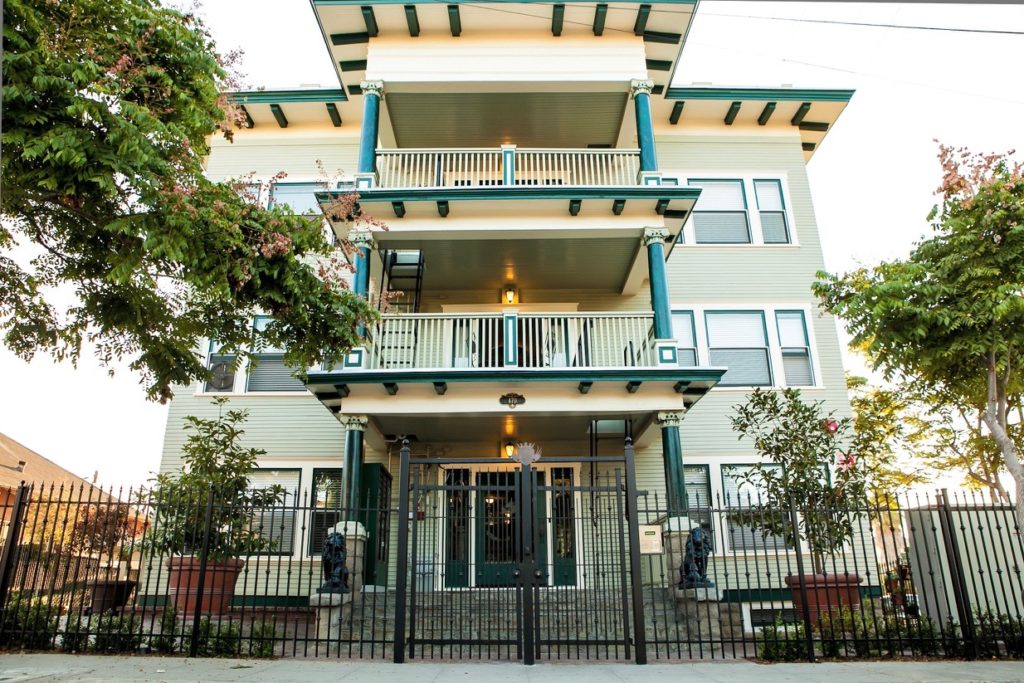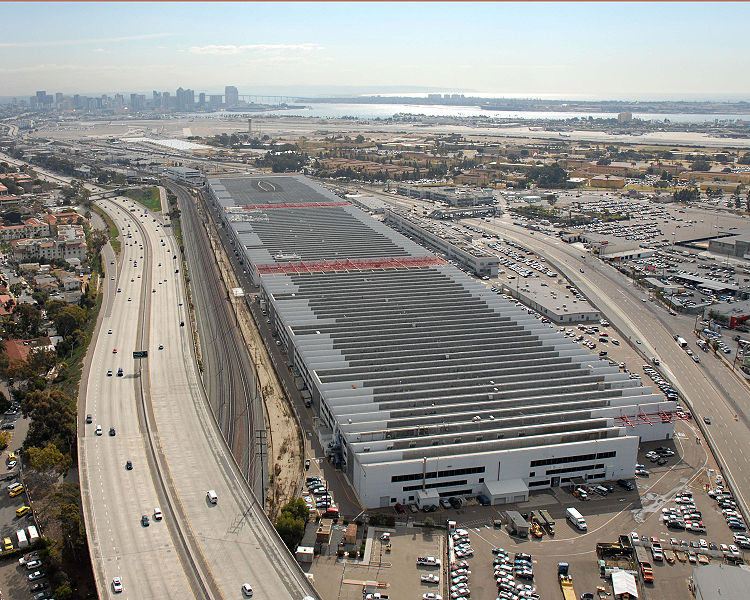Daily Business Report-April 24, 2020
A well-stocked, empty supermarket before the pandemic. (Photo by tes from FreeImages)
How COVID-19
Consumer Spending is
Impacting Industries
How do consumers plan to spend money during the pandemic?
Visual Capitalist highlights survey results from 13 countries, to show which industries are benefiting — and which are in trouble.
Click here to view the infographic
________________________________
New SANDAG report examines pandemic
impacts on regional employment
Nearly 300,000 residents unemployed; unemployment rates hover between 16-27 percent throughout the region
The SANDAG Data Science and Analytics team examined and analyzed local and state data that indicates nearly 300,000 regional residents have lost their jobs due to the economic shutdown caused by the COVID-19 pandemic.
The SANDAG report, COVID-19 Impact on the San Diego Regional Economy: Employment Analysis, outlines the geographical distribution of lost jobs and calculates unemployment rates for segments of the region.
The communities of South Bay and Central San Diego have been the hardest hit by the mass loss of jobs.
“SANDAG is in a unique position to analyze data it collects to develop reports and economic forecasts that can help inform regional leaders. These reports can be used as tools to help in our recovery planning efforts,” said SANDAG Executive Director Hasan Ikhrata. “I’m very proud of Chief Economist Ray Major and his team for putting in long hours to get this done.”
The new SANDAG report examines unemployment in the region by place of residence and place of work.
“The reality is that hundreds of thousands of San Diegans have lost their primary source of income,” said SANDAG Chief Economist Ray Major. “We hope this report gives regional leaders a broad understanding of the impacts and will help in developing protocols to allow people to safely return to work and restart the region’s economy.”
Some employment centers have been hit harder than others, depending on the concentration of businesses in the tourism, retail, food and beverage services, and personal services industries.
Hotel and motel occupancy is anticipated to remain low through 2020 as the tourism sector struggles to recover. Local entertainment venues, amusement parks, attractions, concert arenas, casinos, and baseball parks also will be impacted due to reduced travel and social distancing regulations.
In the San Diego region, communities that have struggled most during the pandemic include the South Bay and Central San Diego where unemployment rates are 22-27 percent.
Click here to see the full SANDAG report
________________________________
Real estate group and economist
Alan Nevin give 1st quarter market report
Through its partnership with Alan Nevin, a local San Diego demographic and real estate economist, the Greater San Diego Association of Realtors has released a first quarter 2020 economic report including the impact and outlook of the COVID-19 impact on real estate.
Nevin provides the Association and MLS members with monthly and quarterly updates outlining the market conditions and trends for San Diego County. With the fast-moving news during this health crisis, he has included insights on the coronavirus impact on the local real estate market.
In his recent report, Nevin notes that home sales in March 2020 almost matched March 2019, and home closings in the first three months of the year were ahead of last year.
Nevin also highlighted that demand for homes remains high, with the days on the market until closing averaging 26 days, compared to 35 days in 2019 for detached homes, and 24 days, compared to 35 days in 2019 for attached homes. Inventory of homes for sale and months’ supply of inventory declined significantly, which Nevin points out is good for home sellers.
Click here to read the full report.
________________________________
San Diego airport’s Terminal 1 expansion
plans still on, despite pandemic
Though COVID-19 has at least temporarily shelved most flights in and out of San Diego, airport authorities say the projected $3 billion proposed expansion of Terminal 1 remains a go, and that there are no plans to alter the project’s timetable.
Planned new improvements to ’60s-era Terminal 1 would feature adding 11 new gates to the present 19 bringing the total to 30 adding more gate-area seating, restaurants and shops and additional security checkpoints with more lanes and a host of energy-efficiency upgrades. Terminal 1’s expansion, part of the overall Airport Development Plan, also includes numerous roadway and transportation improvements.
Prior to the pandemic, the timetable for Terminal 1’s redo tripling its current size had construction starting in late 2021, with the first stage of the new terminal opening in 2024, and full completion of terminal gates in 2026.
When it opened in 1967, Terminal 1 served 2.5 million passengers that year. In 2019, the same facility served more than 12 million.
Nicole Hall, senior communications specialist, San Diego County Regional Airport Authority, pointed out San Diego International Airport’s air traffic and passenger volume “mirrors the numbers at airports around the country.”
Asked if there’s a chance plummeting air traffic could scale back – or even scrap – Terminal 1’s expansion, Hall replied: “Currently, passenger volume at Transportation Security Administration checkpoints at airports around the country is down 96 percent compared to one year ago. As of now, the impacts from COVID-19 have not impacted current plans to redevelop Terminal 1, which is a part of the larger ADP.
“Plans for the redevelopment of Terminal 1 have not been changed. However, as we move forward, we will continue to review the potential impacts of COVID-19 on all projects and programs.”
Hall noted public input on Terminal 1’s expansion continues. “The public can provide input at board meetings, which are being held telephonically at this time,” she said.
Recently, the airport received more than $91 million from the newly created Coronavirus Aid, Relief, and Economic Security (CARES) Act Airport Grant Program.
“The relief funds are on a reimbursement basis, so we will draw down funds to reimburse eligible costs expended,” said Hall. “We are still evaluating which costs we will seek reimbursement for. The federal emergency relief funds can be used for capital expenditures, operating expenses, including payroll and utilities and airport debt payments.”
Added Hall: “The executive leadership team, in coordination with the board, will decide which costs will be reimbursed by the grant. The airport is incredibly grateful for this funding, and it will be critical in helping the airport cash flow and current obligations. As many industries are, the airports as a whole are facing unprecedented uncertainty. As time passes, there may be a need for additional assistance for airports around the country. We expect the funds will assist with FY 2020 and a portion of FY 2021 needs.”
In October 2019, the Peninsula Community Planning Board sent a letter to the San Diego County Regional Airport Authority commenting on a draft environmental impact report being circulated on proposed Terminal 1 and airport expansion.
“We object to the DEIR as all the benefits of the airport expansion go to the Airport Authority and the airlines,” said PCPB’s letter. “The burdens of increased noise and pollution all unfairly fall on the residents of Point Loma and surrounding communities like OB. The airport’s position in the DEIR is that these issues of noise and pollution are ‘significant but unavoidable harm’ to the human health of Point Loma residents. This is offensive and unacceptable. The DEIR should not be approved or move forward until real harms to human health are properly addressed.”
Added PCPB’s airport letter: “The SDCRA and the FAA have forecasted airport operations will increase by 15 percent through 2026, to a rate of one arrival or departure every 86 seconds, 17 hours a day, 365 days a year, regardless of whether the ADP is built or not. Thus, the SDCRAA is promoting a $3 Billion ADP proposal, which includes 11 additional gates and additional ‘remain overnight’ aircraft parking places that will increase air traffic arrivals late into the night and stretch the morning departures well into mid‐morning.”
Peninsula resident Casey Schnoor, an airport watchdog and outspoken critic of Terminal 1’s expansion, noted expansion plans are “being pushed forward when, under prior operation levels, airplane capacity was rapidly racing to its maximum, as limited by the single runway… according to prior forecasts used to justify the ADP, by 2026 or soon thereafter, there will be no more room on the runway during the 17 hours per day of non-curfew operations, for any more planes. This is regardless of whether Terminal 1 is rebuilt, remodeled in a less expansive and expensive way, or not at all. There must be a hidden motive\agenda, undisclosed to the public, to push this ADP forward.”
Korla Eaquinta, a 33-year Roseville resident, concurred in a similar letter she sent to the airport.
“The $3 billion ADP does not commit any monies to protect the health of persons in Point Loma or in other affected communities,” she said. “Instead, the ADP will significantly accelerate the airport’s growth rate to reach operational capacity within several years, resulting in three times the current noise, human health consequences as documented by the World Health Organization, greater risks of missed approaches, increased pollution and climate impacts from increased aircraft operations.”
________________________________

Tracing the spread of COVID-19?
There’s an app for that — and privacy concerns
CalMatters
One day in the not-so-distant future, your phone could ping with an alert that you were recently in contact with someone who had COVID-19, suggesting you get tested. Developing a public health surveillance system to monitor, track down and isolate new cases is key to preventing future outbreaks and California relaxing its shelter-in-place order, experts say. But companies like Google and Apple developing apps to track the virus’ spread has reignited a longstanding data-privacy debate, CalMatters’ Ben Christopher reports.
Amnesty International, other organizations in an open letter: Beware of public health campaigns being “used as a cover to usher in a new era of greatly expanded systems of invasive digital surveillance … these are extraordinary times, but human rights law still applies.”
Adam Conner of the Center for American Progress: “The value proposition of an app that allows you to learn if you’ve gotten near to someone with COVID-19,” potentially saving your life, “is pretty compelling.”
________________________________

SENTRE sells 27-unit Sherman Heights
apartment community for $7.3 million
Colonial Revival building holding Mills Act Historic Designation brings $270,000 per unit
San Diego-based commercial real estate investment firm SENTRE announced the sale of The Sterling, a 27-unit apartment building at 470 20th St. in the historic Sherman Heights neighborhood near Downtown San Diego.
Sold for $7.3 million or $270,000 per unit, the property’s buyer is Highlands REIT Inc., which represented itself. In this transaction, SENTRE as the seller was represented by Berkadia Real Estate Advisors including Ed Rosen, John Chu and Tyler Sinks.
The Sterling, a Colonial Revival mid-rise building known as Sophie’s Arms prior to being renamed after its original architect William “Sterling” Hebbard, offers 27 studio and one-bedroom units.
Built in 1908, The Sterling holds a Mills Act Historic Designation as part of the Historic Sherman Heights District, and from its location at the corner of 20th Street and Island Avenue offers immediate access to Downtown San Diego’s East Village and Petco Park.
The property was originally acquired by SENTRE in April 2016 for $5.3 million as part of SENTRE’s “Living” brand, which has included investments in nearly a dozen other properties throughout San Diego County.
________________________________
Augeo acquires San Diego-based
Empyr to create card-linking company
Empyr, a San Diego-based card-linking platform for national brands and digital publishers, has been acquired by Augeo, a Minnesota engagement and loyalty platform company. Together, they will launch a new company called Figg, combining the financial institution card-linking business of Augeo with the extensive publisher experience of Empyr.
Augeo will continue to serve its extensive clientele independently, while the new company will represent one of the largest user bases in the card-linking industry, with more than 60 million users and $300 billion in transaction volume. Figg will bring new card-linked opportunities for advertisers, publishers and consumers, according to Augeo.
“While the timing might seem counter-intuitive, we believe there is an urgent need to bring advanced technology and more encompassing advertiser offer content to consumers seeking greater value,” said David Kristal, Augeo CEO and executive chairman of Figg. “Some retail sectors like grocery, household essentials and health-related products are near capacity, while the travel industry, hospitality, restaurants and many local service businesses are battling to stay afloat. As things begin to improve, Figg will be uniquely positioned to connect consumers with advertisers to help accelerate commerce in the U.S. market.”
The transaction also involved support from Valor Siren Ventures (VSV), a leading innovation engine and market maker in early-stage food, food technology and retail technology investing.
________________________________
EPA honors Encinitas nonprofit for
leading food recovery efforts
ProduceGood of Encinitas was recognized by the U.S. Environmental Protection Agency (EPA) for its outstanding efforts in combatting food waste. The nonprofit received a national Food Recovery Challenge award for reducing food waste and, in the process, conserving natural resources.
“ProduceGood’s zero waste leadership has rescued fresh produce and redirected it to vulnerable individuals and families throughout San Diego County,” said John Busterud, EPA’s Regional Administrator for the Pacific Southwest.“This effort helps reduce waste and costs while feeding people and protecting the environment.”
In 2018, ProduceGood led a sustainable fresh produce recovery practice throughout San Diego County.With 153,967 pounds of excess produce rescued in 2018 from 90 growers, ProduceGood diverted 76.98 tons of edible fruits and vegetables from landfill. Through the efforts of 600 volunteers participating in 260 food recovery events from over 90 growers, ProduceGood upcycled 461,901 servings of nutritious produce to benefit the food insecure of San Diego or for zero waste processing.


